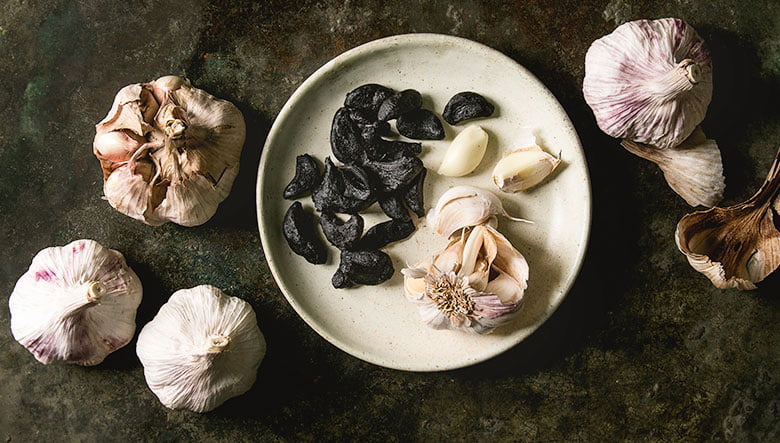From soups and stews to marinades and sauces, garlic is a staple that brings bold flavor to cuisines worldwide. If you’ve explored the world of gourmet ingredients, chances are you’ve encountered black garlic. This dark, sweet, and savory take on the classic bulb is the product of a controlled aging (often called “fermentation”) process. But how does this transformation from raw to black garlic affect one key health metric—its glycemic index (GI)? Below, we dive into what the glycemic index represents, how garlic fits into the picture, and whether black garlic’s unique processing significantly impacts its effect on blood sugar.
What is the Glycemic Index?
The glycemic index measures how quickly a food causes blood sugar levels to rise. Foods higher on the GI scale (like white bread or sugary snacks) are rapidly digested, causing a spike in blood glucose levels. Lower-GI foods (e.g., most non-starchy vegetables) are digested more slowly and lead to a more gradual increase in blood sugar.
Some key points about GI:
-
Scale of 0 to 100: Pure glucose has a GI of 100. Foods below 55 are considered low GI, 56–69 medium, and 70+ high.
-
Serving Matters: GI is based on 50 grams of available carbohydrates in a food. In practice, portion size can drastically affect the glycemic load, which may be more relevant to daily diet.
-
Nutrient Interactions: The presence of fats, fibers, and proteins can affect how the body processes carbohydrates, potentially lowering a food’s effective GI.
Raw Garlic and Its Typical GI
-
Low-Carb & High-Fiber: Garlic in its raw form is very low in total carbohydrates, with a notable amount of fiber. Because of this, raw garlic already has a minimal impact on blood glucose levels.
-
Minimal Usage: Even if garlic had a slightly higher GI, it’s typically used in small quantities for flavoring, which further reduces its real-world impact on blood sugar.
-
Lack of Official GI Data: You may not find a standard GI rating for raw garlic on most charts—largely because it’s rarely consumed in quantities substantial enough to measure in standard GI testing protocols. Nonetheless, it’s widely accepted that raw garlic would be considered very low on the GI scale.
How Does Black Garlic Differ?
1. Fermentation-Style Aging
Black garlic is produced by aging raw garlic bulbs in a warm, humid environment over several weeks (sometimes up to two months). This extended heat exposure triggers the Maillard reaction, the same browning process that occurs when searing steak or toasting bread, which transforms the garlic’s color, flavor, and certain chemical components.
2. Sugar Conversion
During the Maillard reaction:
-
Some starches and complex carbohydrates in the garlic may convert into simpler sugars.
-
This process imparts black garlic’s characteristic sweet, caramelized flavor.
Even though black garlic can taste sweeter than raw garlic, the total amount of carbohydrates in a clove remains fairly low. However, the proportion of simple sugars (like fructose) can be higher compared to raw garlic.
3. Potential Impact on GI
-
Slightly Higher GI? The increase in simpler sugars might theoretically raise the GI of black garlic compared to its raw counterpart.
-
Still Likely Low: Because you’re still only consuming small amounts of garlic at a time, the practical impact on blood sugar remains minimal. Plus, the total carbohydrate content per clove is still low.
-
Beneficial Compounds: Black garlic also retains various bioactive components (and may even boast higher antioxidant levels), which could offset blood sugar spikes when part of a balanced diet.
Glycemic Load vs. Glycemic Index
When evaluating foods like garlic—eaten in small amounts—it’s useful to consider glycemic load (GL). Glycemic load factors in both the quality and quantity of carbohydrates in a typical serving size.
-
GL Calculation:
-
Low GL in Practice: Even if black garlic had a moderate GI rating (purely hypothetically), the actual grams of carbohydrate in one or two cloves is tiny. Therefore, the glycemic load will still be minimal.
Health Considerations and Benefits
While garlic—raw or black—is unlikely to dramatically affect blood sugar, it does offer potential benefits:
-
Antioxidant Rich: Black garlic can have higher antioxidant levels, potentially supporting overall health.
-
Potential Heart Health Support: Some research ties garlic consumption to cardiovascular health benefits.
-
Improved Digestibility: Individuals who find raw garlic too pungent or harsh on the stomach sometimes tolerate black garlic better, thanks to reduced sulfur compounds.
As always, if you have specific health concerns—like diabetes or pre-diabetes—consulting a healthcare professional for personalized advice is key.
Tips for Using Black Garlic Without the Blood Sugar Spike
-
Combine with Protein & Fiber: Pair black garlic with proteins (chicken, fish, tofu) and fiber-rich vegetables to moderate any effect on blood glucose.
-
Keep Portions Reasonable: Thankfully, a little black garlic goes a long way in flavor—no need to overdo it.
-
Experiment with Recipes: Use it in sauces, marinades, or mixed into spreads. The mild sweetness can enhance many dishes without piling on extra carbs.
Final Thoughts
While the fermentation process that creates black garlic does transform its flavor and slightly alter its sugar profile, the net impact on the glycemic index is still modest. Raw garlic already has a minimal effect on blood sugar—black garlic, with its sweet-and-savory depth, is unlikely to spike glucose levels in practical serving sizes. If you’re looking for a unique, flavorful ingredient that’s gentle on your blood sugar, black garlic could be a perfect fit.
Have you tried incorporating black garlic into your diet? Feel free to share your favorite recipes, experiences, or health tips in the comments below!

Comments (0)
No comments yet. Be the first to comment!